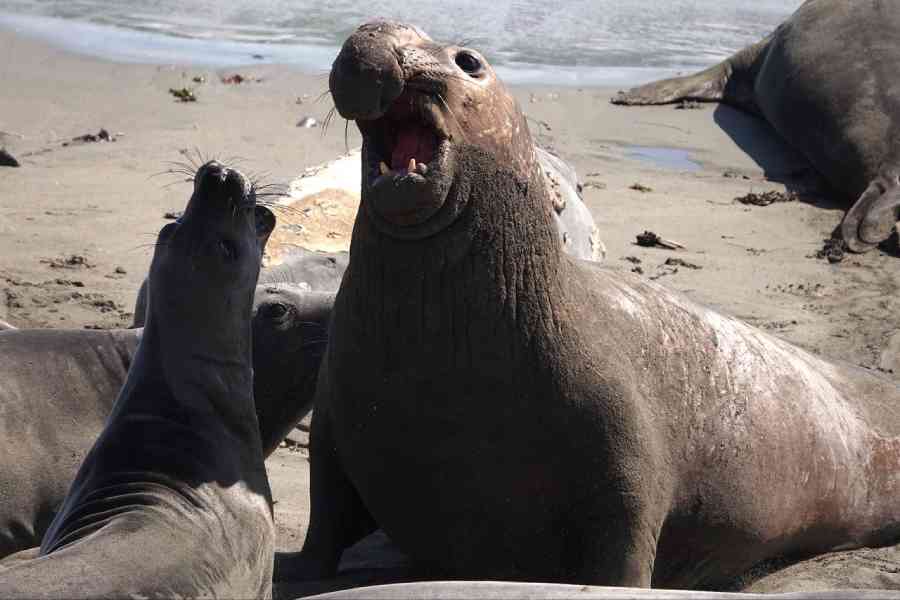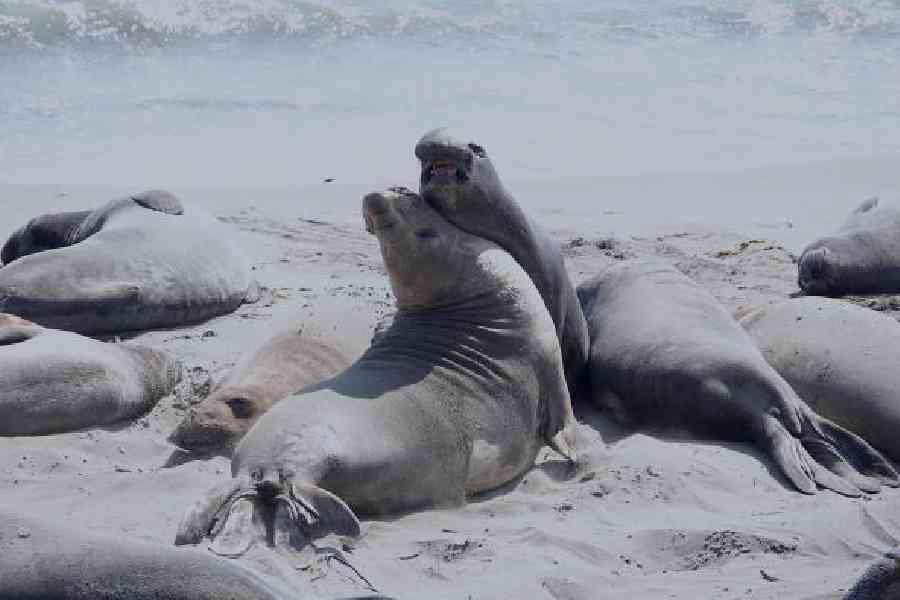Drive just seven miles north of San Simeon, California, and a majestic sight meets your eyes. Right there on the beach lies the Piedras Blancas Elephant Seal Rookery. This four-mile stretch of beach on the US West Coast is home to approximately 1,000 northern elephant seals. This is their territory and they continue to haul themselves out of the salty water year after year.

Northern elephant seals live in the eastern Pacific Ocean
I had read about it and resolved to see it for myself on my recent trip to the US in June. As I approached the viewing area on the beach, I felt a deep sense of peace. Away from human habitation, I could hear breakers and the elephant seals’ cries, a medley of grunts, barks, and mews, punctuated by an occasional roar that merged with the sound of the ocean. At one point, I could see only the seals in the hundreds and hardly any beach.
As I came closer, there they were: hundreds and hundreds of them playing, resting, sunbathing, and frolicking in what was clearly their zone. It takes a short while to identify the shapes and then it becomes a sight to remember.
According to reports, San Simeon beach is the one place with the highest concentration of northern elephant seals.
The elephant of the ocean
Named because of the distinctive trunk-like nose of the male, northern elephant seals live in the eastern Pacific Ocean. They can weigh up to 5,000 pounds (about 2,268kg) and spend most of their lives in the ocean, hunting for food. Their diet primarily consists of fish and squid, but they also hunt rays and sharks. They spend about nine months of the year in the water and come ashore to molt, mate, and give birth.
On land, these huge animals tend to lose a good part of their agility and move with considerable effort, laboriously dragging their bodies, using their belly and front flippers.

They can weigh up to 5,000 pounds (about 2,268kg) and spend most of their lives in the ocean, hunting for food
These animals can easily measure up to 13 feet in length, with adult males ranging between 14 to 16 feet.
Back from the brink of extinction

Other than meat, seals were once hunted for their blubber, the thick layer of adipose tissue that lies directly under their skin
If you remember your geography lessons in school, a common question about Inuits was what their diet used to be. The answer invariably included seals. Judging from their preponderance in Alaska and Mexico, it is not too difficult to deduce that northern elephant seals were actively hunted by populations living in these areas.
Other than meat, seals were hunted for their blubber, the thick layer of adipose tissue that lies directly under their skin. Blubber has been used extensively as both food and fuel. The resulting scenario was such that between 1884-92, not a single northern elephant seal was to be found anywhere, according to Northern Park Service.
Thanks to the efforts of some non-profit organisations in the area, elephant seals are back on the mainland in the thousands, offering visitors the unique chance to observe them as they live in the wild.
How to reach San Simeon
Sitting between Los Angeles and San Francisco is the seaside town of San Simeon. With plenty of natural attractions, it also boasts architectural splendour. The Hearst Castle draws more than a million visitors each year and is a fine example of Gilded Age opulence. But it’s the natural world that draws me and I was in complete awe of the Piedras Blancas Elephant Seal Rookery.
The ride from Los Angeles is spectacular with the rolling sea on one side and mountains with verdant vegetation on the other. We passed unmissable spots as we crossed cities, towns, and villages en route.

On land, these huge animals lose most of their agility
Said to be one of the most rewarding drives in the world, I experienced it first-hand, driving an SUV with my family and cousins as passengers.
Upon reaching the place, I lost no time in soaking in the rich experience, reaching for my photography gear as I climbed up the San Simeon Elephant Seal Broadwalk. I strongly recommend the place to anyone who is even remotely interested in the environment and wildlife, as it makes for an eclectic experience.
As it was a day trip for us (there’s decent accommodation available by way of hotels and lodges in the town just in case you wish to stay back), we came away with the memory of a lifetime. We had lingered the whole day and had seen and heard enough to make it last forever.
Northern elephant seals spend about nine months of the year in the water and come ashore to molt, mate, and give birth. On land, these huge animals tend to lose a good part of their agility and move with considerable effort, laboriously dragging their bodies, using their belly and front flippers.
Points to note
While it is an out-of-the-world experience to watch the thriving numbers of a still-endangered animal, do remember it is their space and they should be left undisturbed. Keep the decibel low.
Elephant seals are intimidating. They are large, have sharp incisors, and their bites can carry bacteria. They are wild animals and while the young ones may be curious about humans in the vicinity, do keep your distance.
If you have your pet with you, it is a good idea to keep a strict guard. Keep dogs on a leash. Elephant seals can move surprisingly fast when they wish.
Apart from the seals, the beach is a rich and dynamic spot for plenty of fauna. Take your time to explore and discover the other residents as well.I filled my lungs with the wonderfully tangy sea air carrying the smell of sea kelp and local phytoplankton. You should too.

Shiladitya Chaudhury is a communication consultant and a restaurateur co-owning popular brands Oudh 1590 & Chapter 2. His passion for wildlife photography takes him to the remotest of jungles.
